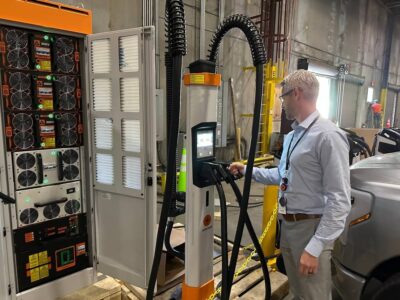(Bloomberg) —
When Sterling Infrastructure Inc. Chief Executive Officer Joe Cutillo first started telling Wall Street that factories would return to the US, everybody thought he was crazy.
“The first fifteen years of my career were more about consolidation. Moving manufacturing to Mexico or Asia or to Eastern Europe,” Cutillo said in an interview. “It is truly the first time in my life I’ve seen stuff coming back.”
American firms’ mentions of nearshoring, reshoring and onshoring — synonyms for moving manufacturing back or closer to a company’s home country — grew by an average of 216% year over year since the start of 2022, data compiled by Bloomberg showed. That’s as private companies announced $516 billion of investments since President Joe Biden took office, according to White House figures last updated September 26.
That half a trillion dollars is less a catalyst and more the escalation of a trend that started gaining traction during the Trump administration. “The trade war [with China] was the first big shock,” Bloomberg Senior Geo-Economics Analyst Gerard DiPippo said in an interview.
But it was the pandemic that crystallized the fragility of the globalized supply chain, spurring companies to accelerate their nearshoring plans in earnest. Backlogged ports and high-profile shipping blockages in the all-important Suez and Panama canals illustrated the risks of relying on cheap production in Latin America and Asia, while advances in automation and rising freight costs have made it more economically attractive to move production back to the US.
That means boom-time for the little-known companies building all of the new factories, data centers and warehouses, like Sterling Infrastructure — its market value jumped 506% in the past four years, to $2.4 billion from $390 million. Contracting giant Quanta Services Inc. grew nearly fivefold to $25 billion in that time, while peers TopBuild Corp., Emcor Group Inc. and Fluor Corp. rallied over 100%.
Demand for nearshoring-related construction is coming from a wide array of industries including life sciences, hospitals and technology. Breakthroughs in artificial intelligence have driven demand for data centers, Sterling’s Cutillo said, powering sales growth of 20% to 30% in recent years. “We don’t see any slowdown happening in data center” projects, he said.
Foreign companies are joining American firms in boosting US-based manufacturing. In Georgia, Sterling is helping both South Korea’s Hyundai Motor Co. and California-based Rivian Automotive Inc. build electric-vehicle plants encompassing 1,100 acres in total.
Read more: US Factory Boom Brings Billion-Dollar Projects to Tiny Towns
Many construction companies now have large and rapidly growing waiting lists as a result. Quanta, Fluor, and three of its peers have a combined backlog of nearly $120 billion, about $20 billion higher than their pre-pandemic average. And that’s expected to have grown by about 4% sequentially in the third quarter.
Spending on construction and manufacturing reached $198 billion on an annualized basis in August, jumping almost 66% from last year to the highest level since the Bureau of Economic Analysts began tracking the data in the 1950s.
Much of that recent spending surge is attributable to a pair of laws pushed through Congress by the Biden administration that together offer billions in subsidies, tax credits and other incentives to foster local manufacturing of semiconductors and electric vehicles — geopolitically significant industries in which China has taken major strides in recent years.
Read more: Huawei’s Surprise Comeback Marks New Phase in the Tech Cold War
Congress can’t take all the credit though. “These trends were happening with or without government stimulus,” Emcor CEO Tony Guzzi said in an interview. “The government stimulus solidifies demand or elongates demand.”
And while billions more have been set aside in a third bill for supportive infrastructure like roads and airports to connect the newly minted factories, Cutillo says more is needed: “We’re nowhere near the levels you really need to spend on the infrastructure,” he said.
The appeal of nearshoring will likely grow as US-China relations remain tense. President Biden has allowed Trump-era tariffs on Chinese goods to continue, while US Commerce Secretary Gina Raimondo said in August that businesses are telling her the country is becoming “uninvestible because it’s become too risky.” For the first time since 2004, China fell to America’s third largest trading partner last year, after Mexico and Canada, according to data compiled by Bloomberg.
Presidents Biden and Xi Jinping may meet for the first time in about a year at next month’s Asia-Pacific Economic Cooperation summit as the two superpowers look to steady ties wobbled by the nearshoring boom.
“It is eroding what has been called the ballast of the relationship, which was the economic and commercial relationship,” Bloomberg’s DiPippo said.
© 2023 Bloomberg L.P.





